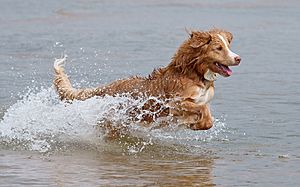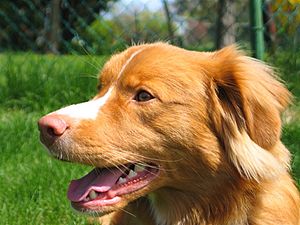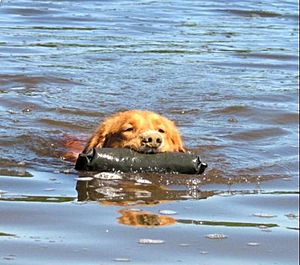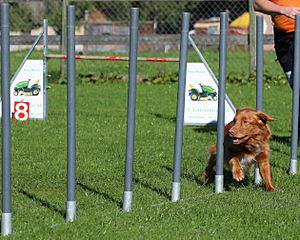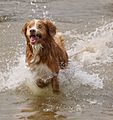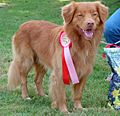Nova Scotia Duck Tolling Retriever facts for kids
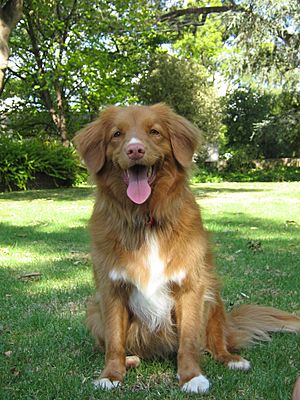
An example of an adult female toller
|
|||||||||||||||||||||||||||||||||
| Other names | Yarmouth Toller, Tolling Retriever, Little Red Duck Dog, Little River Duck Dog | ||||||||||||||||||||||||||||||||
|---|---|---|---|---|---|---|---|---|---|---|---|---|---|---|---|---|---|---|---|---|---|---|---|---|---|---|---|---|---|---|---|---|---|
| Common nicknames | Toller, Duck Toller | ||||||||||||||||||||||||||||||||
| Origin | Canada (Nova Scotia) | ||||||||||||||||||||||||||||||||
|
|||||||||||||||||||||||||||||||||
|
|||||||||||||||||||||||||||||||||
| Notes | Provincial dog of Nova Scotia | ||||||||||||||||||||||||||||||||
| Domestic dog (Canis lupus familiaris) | |||||||||||||||||||||||||||||||||
The Nova Scotia Duck-Tolling Retriever is a special type of hunting dog from Canada. It was first bred in the 1800s to help hunters attract ducks and bring them back. These dogs are about 43 to 53 centimeters (17-21 inches) tall. They usually weigh between 19 and 23 kilograms (43-51 pounds).
They are the smallest of all the retriever dog breeds. Their thick, waterproof fur keeps them warm in cold water.
Contents
History of the Toller Dog Breed
This dog breed was first developed in a place called Little River Harbour. This community is in Yarmouth County, Nova Scotia, Canada. This happened around the early 1800s.
The Toller was first known as the Little River Duck Dog. In 1945, the Canadian Kennel Club officially recognized it. They said it was a purebred dog. The Toller breed is a mix of several other dogs. These include retrievers, spaniels, setters, and possibly a farm collie.
The breed became well-known across Canada in 1980. In 1995, it was named the official provincial dog of Nova Scotia. This happened after two Tollers won top awards at big dog shows.
How Tollers Help Hunters
Tollers get their name from their special ability to "toll" or lure waterfowl. This means they attract ducks and geese closer to the hunter. The hunter stays hidden in a blind. The dog then runs and plays near the water. Often, the hunter throws a ball or stick for the dog to fetch.
The Toller looks a bit like a fox. Its playful actions and white markings make ducks and geese curious. The birds then swim closer to see what is happening.
When the birds are close enough, the hunter calls the dog back. Then the hunter stands up, which makes the birds fly away. This gives the hunter a chance to shoot. After a bird is shot, the Toller retrieves it. These dogs are great at fetching in cold water. This is because of their special water-repellent double coat.
What a Toller Looks Like
Appearance and Features
People sometimes mistake Tollers for small Golden Retrievers. However, Tollers are more active, both in body and mind. Tollers are strong, muscular, and well-built dogs. They have deep chests and sturdy legs. Their feet are webbed, which helps them swim.
Tollers can be different shades of red or orange. This can range from a golden red to a dark coppery red. Lighter fur, called feathering, is found on their tail, legs, and body. The lighter red colors are still rich and deep. Tollers should not be buff, brown, or beige.
Most Tollers have some white markings. These are usually on the tip of their tail, their feet, or their chest. It's okay if a Toller has no white markings. Dogs with white on their shoulders, ears, neck, or back are not allowed in dog shows. Also, dogs with silvery, grey, or black fur are not allowed.
Toller's Special Coat
Tollers were bred to retrieve things from icy water. Because of this, they have a special double coat. The outer coat is medium length and soft. The inner coat is dense and soft. This coat repels water. The fur on their back might have a slight wave, but it is mostly straight. In winter, some Tollers might have a long, loose curl around their throat.
Their tail is covered with soft, medium-length fur. They hold their tail up happily when they are excited. The fur on their nose area is short and fine. Tollers will shed their fur more during certain seasons.
Head and Face
Dog breeders who show Tollers think the head is very important. It should be clean-cut and shaped a bit like a wedge. It should also look like a fox. It should not be blocky like a Golden Retriever's head. Their ears are triangle-shaped and set high on their head.
A Toller's nose, lips, and eye rims should all be the same color. They can be black, which often fades as the dog gets older, or liver-colored. Their lips fit snugly around their mouth. Tollers have a "scissor bite," meaning their top teeth slightly overlap their bottom teeth. They need strong jaws to carry a large bird. But they also need a "soft mouth" so they don't damage the bird. Their eyes are set wide apart, are almond-shaped, and medium-sized. They can be amber to dark brown. Their expression looks friendly, alert, and smart.
Size of Tollers
Tollers are the smallest of all the retriever dog breeds. They stand about 43 to 53 centimeters (17-21 inches) tall at the shoulder. They weigh between 13.5 and 22.5 kilograms (30-50 pounds). Female Tollers are usually a bit shorter and lighter than males.
Toller Temperament and Behavior
Nova Scotia Duck Tolling Retrievers are known to be very smart and curious. They are alert, friendly, and have lots of energy. They are loving, eager to please, and busy dogs. They usually get along well with children. They can be good family dogs. However, future owners should know that Tollers need a lot of physical and mental activity. If they don't get enough exercise or are left alone too long, they might become destructive.
Duck Tollers are working dogs. They are happiest when they have a job to do. They are excellent hunting partners. They are also great at many dog sports. These include agility, dock diving, and obedience. Their excellent sense of smell, intelligence, and desire to work make them perfect search and rescue dogs. The breed standard says they should love to retrieve, be very interested in birds, have lots of energy, and love water.
Tollers do not have an aggressive bark. Some have a special bark called the "Toller scream." This is a high-pitched, howl-like sound. People often call it their "singing." They don't use this sound when they are angry. Instead, the "Toller scream" happens when they are very excited.
How Tollers Socialize
Tollers can be very social dogs. But it's important to help them meet new people and animals when they are young. Tollers are energetic and friendly with their owners. However, they can be a bit shy around strangers. It's very important for young Tollers to experience new people, places, smells, and sights. This helps them grow into well-behaved adults.
They usually get along well with other dogs. But they have a strong natural urge to chase small animals. This is called a "prey drive." They might chase cats or other small pets. This can be avoided if they meet cats, for example, when they are very young. If Tollers are not socialized enough when they are young, they might become aggressive, destructive, or timid when they grow up.
Activities Tollers Enjoy
Tollers are known to be excellent in many dog sports and jobs. Their high energy and intelligence make them great for difficult tasks. These tasks need a lot of focus and skill. Tollers love to work and be outdoors. So, it's no surprise they are good at many activities.
Dog clubs around the world recognize Tollers as athletic, smart, and driven dogs. They can do well in many activities. These include dog agility, dock jumping, disc catching, flyball, lure coursing, obedience, search and rescue, therapy dog, and hunting.
Images for kids
See also
 In Spanish: Retriever de Nueva Escocia para niños
In Spanish: Retriever de Nueva Escocia para niños


